
|
|
|
|
|
Class Prep
|
|
|
|
Creating Worlds
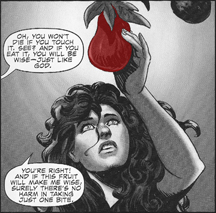 Creation stories don't so much tell a tale of how everything came into being in the past. Instead, they project a sense of order into time, telling the meaning and purpose of the world in the mode of an origin story. A myth of creation thus gives us a window onto the ideal order its author attributes to God, to human community, and to nature, and to the relationship of all three. As those three nodes change, the old stories have to be replaced or adapted. And they are changing all the time—within our own lives, between generations, in diverse cultures, and in the wake of scientific discoveries. Creation stories don't so much tell a tale of how everything came into being in the past. Instead, they project a sense of order into time, telling the meaning and purpose of the world in the mode of an origin story. A myth of creation thus gives us a window onto the ideal order its author attributes to God, to human community, and to nature, and to the relationship of all three. As those three nodes change, the old stories have to be replaced or adapted. And they are changing all the time—within our own lives, between generations, in diverse cultures, and in the wake of scientific discoveries. -
- The biblical account of the creation of the world and the broken relationship that ensues between God and creation was retold multiple times in the Bible itself, in two creation stories and in a flood and recreation story—and that's just within the first 11 chapters of Genesis! In much the same way, Genesis 1–2 was "retold" by countless artists, including Michelangelo on the ceiling of the Sistine Chapel (see below), and while Jewish artist Samuel Bak shattered that meme in a 1999 series of paintings, his evocation of the hint of God's hand still operative in a bleak post-war landscape suggests that hope and faith are possible even if their grounding stories no longer make sense as such. (Your questions for today are below Bak's images.)
-
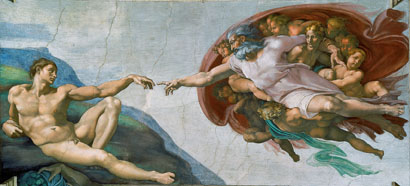 |
Michelangelo, Creation of Man
(Sistine Chapel, 1511–1512) |
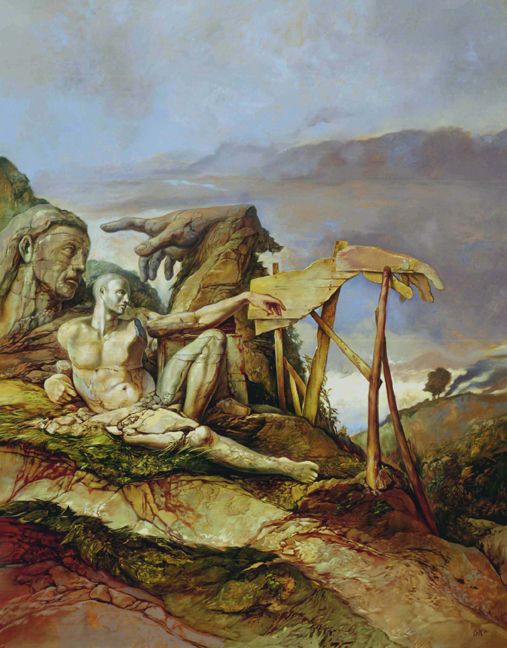 |
|
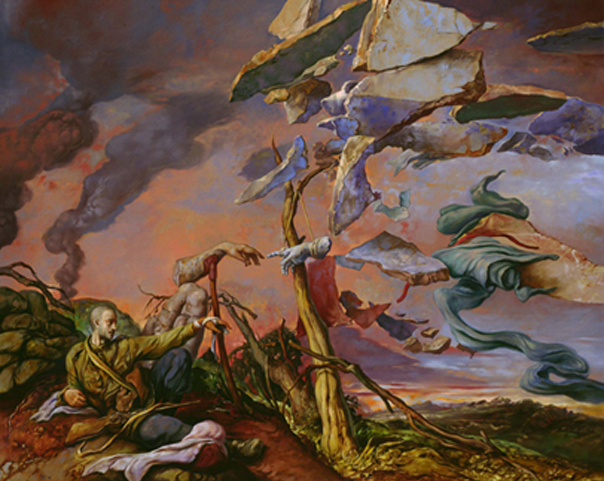 |
|
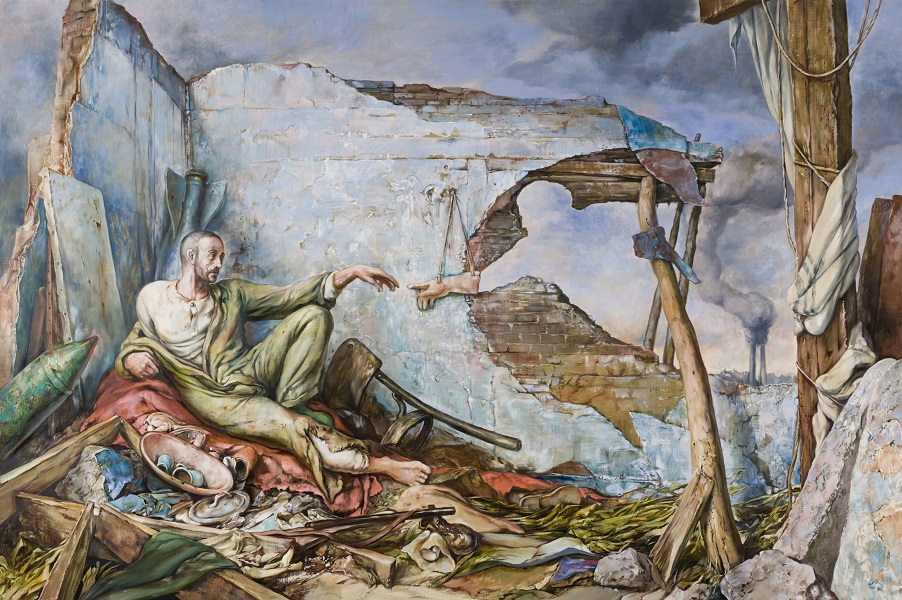 |
Samuel Bak
Searching (1999) |
|
Samuel Bak
Creation (1999) |
|
Samuel Bak
Creation of Wartime III (1999) |
-
- As you do today's reading, prepare the following questions. Note that for question #1, you need to prepare a printed page.
-
- Outline the order of the 2 creation stories in NRSV Genesis in parallel columns (story #1 is Gen 1:1–2:4a, and story #2 is Gen 2:4b-25). Underneath the columns, summarize the differences in a bullet list. Then check and supplement your results with McKnight and Levine's observations on pp. 198-213 of The Meaning of the Bible. You can use this Word template to type in your responses, or just print this pdf and handwrite your answers. Finally, consider whether and/or how The Action Bible changes the story/ies.
- Using those same pages of The Meaning of the Bible, list the differences and similarities between the Babylonian creation myth, the Enuma Elish, and the Genesis myths.
- In Genesis 7, there are two versions of the flood spliced together, sometimes verse by verse. Can you identify the two versions by finding contradictory details? Try to do this yourself first, and then check your results against McKnight and Levine's pp. 221-224 in The Meaning of the Bible.
- Discuss the view in the two Genesis creation stories (not Gen 3) of the relative power of the male and female and of sexuality (The Meaning of the Bible, pp. 296-304).
-
-
- Assigned Readings
-
- Primary: Genesis 1–11 (Action Bible 17-39; read the NRSV version of Genesis 1–3; 7 closely)
-
- Secondary: Knight & Levine, The Meaning of the Bible chapter 7 and pages 295-304; online class prep
-
- Slides for Lecture
-
-
- Today's Authors
-
| |
 |
Douglas Knight is the Drucilla Moore Buffington Professor of Hebrew Bible Emeritus and retired Professor of Jewish Studies at Vanderilt University Divinity School in Tenessee. |
| |
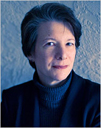 |
Amy-Jill Levine is the University Professor of New Testament and Jewish Studies, the E. Rhodes and Leona B. Carpenter Profesor of New Testament Studies, and Professor of Jewish Studies at Vanderilt University Divinity School in Tenessee. She is a specialist in the Christian Gospel of Matthew and in feminist studies, and is an Orthodox Jew. She will also be our guide through the parables of Jesus when we turn to the New Testament. |
| |
 |
Sergio Cariello is a Brazilian-American comic book artist. He's published with major comic book publishers such as Marvel Comics and DC Comics, and recently has been penciling and inking "The Lone Ranger" for Dynamite Entertainment" and the "Son of Samson" series for Christian publisher Zondervan. |
| |
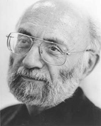 |
Samuel Bak is a Jewish artist born in 1933 in Vilna, Poland. His first artistic exhibit was in the Ghetto of Vilna when he was nine. Escaping the holocaust with his mother (he lost his father and all four grandparents), he studied art first in Israel and then in Paris. He has had solo exhibitions at private galleries in New York, Boston, London, Paris, Berlin, Munich, Tel Aviv, Jerusalem, Zurich, and Rome (among others!). |
-
-
- Further Reading
-
- Blenkinsopp, Joseph. Creation, Un-creation, Re-creation: A Discursive Commentary on Genesis 1–11. New York: T&T Clark International, 2011.
-
- Fewell, Danna Nolan and Gary A. Phillips. "From Bak to the Bible: Imagination, Interpretation, and Tikkun Olam." Arts 21:1 (2010) 21-30.
-
- Goodman, Lenn E. Creation and Evolution. New York: Routledge, 2010.
-
- Heidel, Alexander. The Babylonian Genesis: The Story of Creation, 2nd ed. Chicago: University of Chicago Press, 1963; original, 1951.
-
- Hubard, Olga. "Concepts as Context: Thematic Museum Education and Its Influence on Meaning Making." International Journal of Art and Design Education 33:1 (2014) 103-106.
-
- Matthews, Victor Harold and Don C. Benjamin. Old Testament Parallels, 3rd ed. Mahwah, New Jersey: Paulis,t 2006. Our library has the 1991 edition.
-
- Ruescher, Scott. "Twists of the Wrist: Bak's Recent Paintings, Reviewed." Arts Editor (1 December 2000). Online, http://artseditor.com/site/twists-of-the-wrist/, accessed 13 October 2015.
-
-
- Video Links
-
-
-
- Acknowledgements
-
- Image adapted from Sergio Cariello, illustrator, The Action Bible: God’s Redemptive Story (Colorado Springs, Colorado: David C Cook, 2010) 22.
|
|
|
|
|
